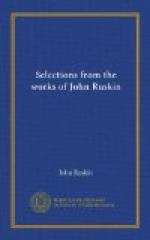power of the Furies and the Harpies mingled, enraging,
and polluting; that so long as you looked at it, no
perception of pure or beautiful art was possible for
you. Suppose I were to tell you that! What
would be the use? Would you look at Gustave Dore
less? Rather, more, I fancy. On the other
hand, I could soon put you into good humour with me,
if I chose. I know well enough what you like,
and how to praise it to your better liking. I
could talk to you about moonlight, and twilight, and
spring flowers, and autumn leaves, and the Madonnas
of Raphael—how motherly! and the Sibyls
of Michael Angelo—how majestic! and the
Saints of Angelico—how pious! and the Cherubs
of Correggio—how delicious! Old as
I am, I could play you a tune on the harp yet, that
you would dance to. But neither you nor I should
be a bit the better or wiser; or, if we were, our
increased wisdom could be of no practical effect.
For, indeed, the arts, as regards teachableness, differ
from the sciences also in this, that their power is
founded not merely on facts which can be communicated,
but on dispositions which require to be created.
Art is neither to be achieved by effort of thinking,
nor explained by accuracy of speaking. It is the
instinctive and necessary result of power, which can
only be developed through the mind of successive generations,
and which finally burst into life under social conditions
as slow of growth as the faculties they regulate.
Whole aeras of mighty history are summed, and the passions
of dead myriads are concentrated, in the existence
of a noble art; and if that noble art were among us,
we should feel it and rejoice; not caring in the least
to hear lectures on it; and since it is not among
us, be assured we have to go back to the root of it,
or, at least, to the place where the stock of it is
yet alive, and the branches began to die.
And now, may I have your pardon for pointing out,
partly with reference to matters which are at this
time of greater moment than the arts—that
if we undertook such recession to the vital germ of
national arts that have decayed, we should find a more
singular arrest of their power in Ireland than in
any other European country. For in the eighth
century Ireland possessed a school of art in her manuscripts
and sculpture, which, in many of its qualities—apparently
in all essential qualities of decorative invention—was
quite without rival; seeming as if it might have advanced
to the highest triumphs in architecture and in painting.
But there was one fatal flaw in its nature, by which
it was stayed, and stayed with a conspicuousness of
pause to which there is no parallel: so that,
long ago, in tracing the progress of European schools
from infancy to strength, I chose for the students
of Kensington, in a lecture since published, two characteristic
examples of early art, of equal skill; but in the one
case, skill which was progressive—in the
other, skill which was at pause. In the one case,
it was work receptive of correction—hungry
for correction; and in the other, work which inherently
rejected correction. I chose for them a corrigible
Eve, and an incorrigible Angel, and I grieve to say[236]
that the incorrigible Angel was also an Irish angel!




